Using the NCCI Tools
Code Ranges
The following HCPCS/CPT code ranges are in the tables:
- 00000-09999: Anesthesia Services
- 10000-19999: Surgery (Integumentary System)
- 20000-29999: Surgery (Musculoskeletal System)
- 30000-39999: Surgery (Respiratory, Cardiovascular, Hemic and Lymphatic Systems)
- 40000-49999: Surgery (Digestive System)
- 50000-59999: Surgery (Urinary, Male Genital, Female Genital, Maternity Care and Delivery Systems)
- 60000-69999: Surgery (Endocrine, Nervous, Eye and Ocular Adnexa, and Auditory Systems)
- 70000-79999: Radiology Services
- 80000-89999: Pathology/Laboratory Services
- 90000-99999: Medicine, Evaluation and Management Services
- A0000-V9999: Supplemental Services
- 0001T-0999T: Category III Codes
- 0001M-0010M: MAAA Codes
- 0001U-0034U: PLA Codes
Looking up PTP Code Pair Edits
Your first step in looking up an edit is to choose the PTP Coding Edits link in the menu on the left side of the National Correct Coding Initiative Edits webpage on the CMS webpage.
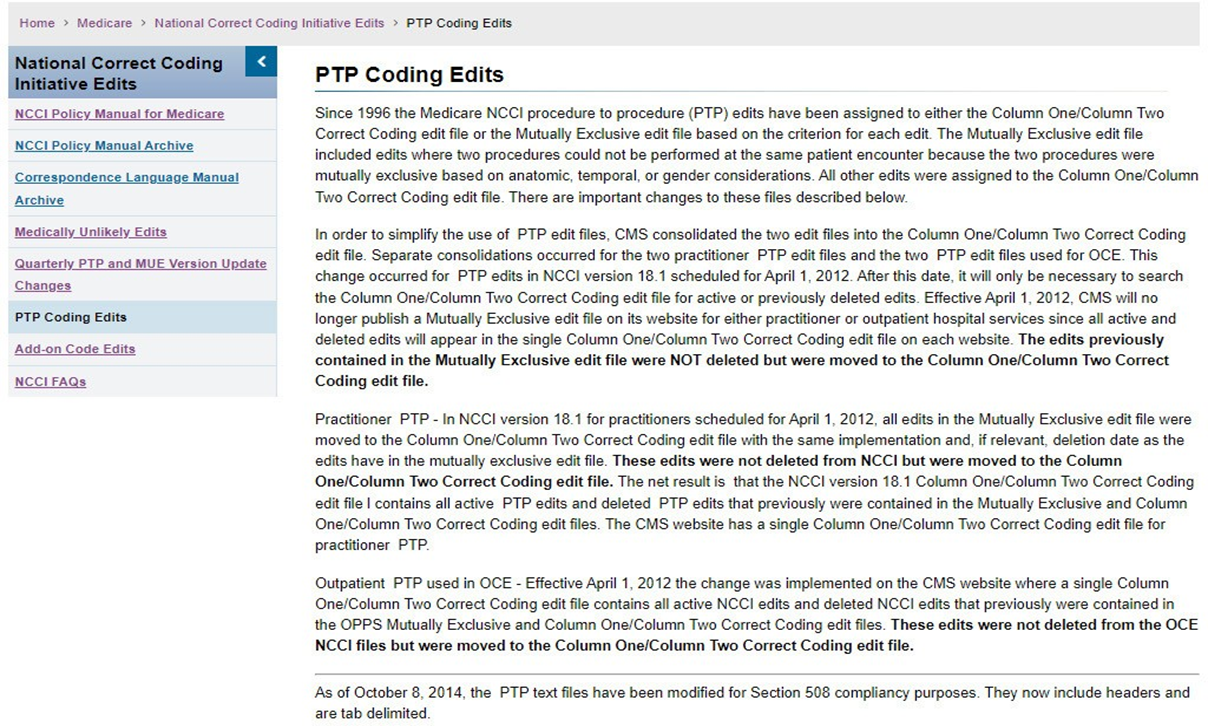
Figure 1: Results from Selecting PTP Coding Edits
Figure 1 shows the screen after selecting PTP Coding Edits. Scroll to the Related Links section at the bottom of the page to find links to the Hospital PTP Edits tables and the Practitioner PTP Edits tables.
We’ll refer to the tables in Figure 1.2 as Hospital PTP Edits Table 1, Hospital PTP Edits Table 2, Hospital PTP Edits Table 3, Hospital PTP Edits Table 4, Practitioner PTP Edits Table 1, Practitioner PTP Edits Table 2, Practitioner PTP Edits Table 3, and Practitioner PTP Edits Table 4.
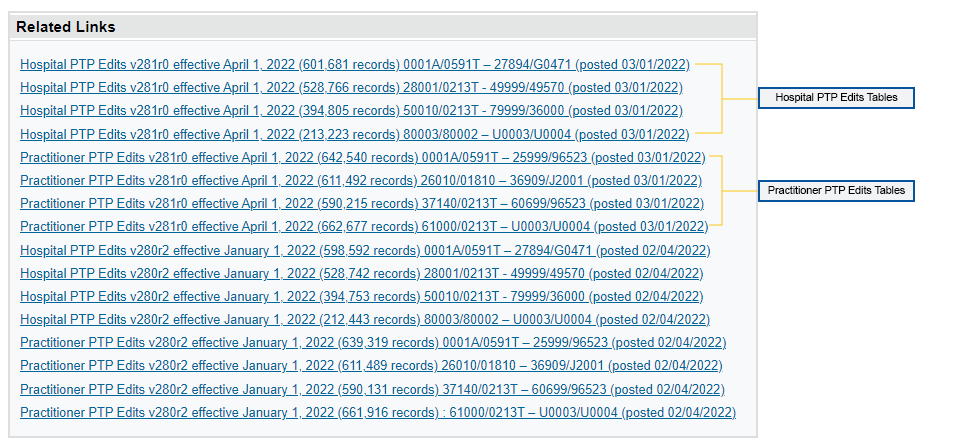
Figure 1.2: Results from Selecting PTP Coding Edits Cont.
The names of the Hospital PTP Edits or Practitioner PTP Edits show the code range of edits listed in the table, beginning with the first Column 1 or Column 2 code edit in the file and ending with the last Column 1 or Column 2 code edit in the file. Column 1 CPT codes, which end with letters M, U, or T, appear in the first table for both Hospital PTP Edits and Practitioner PTP Edits. Column 1 HCPCS Level II codes, which begin with letters A-V appear in the last table for both Hospital PTP Edits and Practitioner PTP Edits.
Click on the Hospital PTP Edits or Practitioner PTP Edits table you want to view or save.
A license agreement will appear. To continue to the table, accept the terms and conditions of the AMA copyright.
You can open the tables in Microsoft Excel (the file ending in xlsx) or text file format.
Helpful Hint
The files are zipped because of their size, which allows for faster download. If the files don’t automatically unzip, you may need the correct software to unzip these files. If you scroll to the bottom of the PTP Coding Edits page and click on Help with File Formats and Plug-Ins, you can download free software. Remember to replace the NCCI tables quarterly and save the tables with the most current information.
How to Use the PTP Code Pair Tables
The Column 1/Column 2 Correct Coding edit tables contain PTP code pairs. We’ll show you how to use the PTP code pair tables, using code 99215 and 2 of the 4 Practitioner PTP Edits tables as our examples. Our examples show the following:
- When a code is the reimbursable code of a PTP code pair
- How to find all PTP code pairs when a code isn’t reimbursable or when it’s only reimbursable with appropriate use of a modifier
- When a modifier may be used
What are the Column 1/Column 2 PTP Code Pair Tables?
Although the Column 2 code is often a part of a more comprehensive Column 1 code, this relationship isn’t true for many edits. In some edits, the PTP code pair edit consists of 2 codes that you shouldn’t report together, unless you use the proper modifier.
For example, you shouldn’t report a vaginal hysterectomy code and total abdominal hysterectomy code together. You shouldn’t report many procedure codes together because they’re mutually exclusive of each other. You shouldn’t report mutually exclusive procedures at the same anatomic site or same patient encounter.
- An example of a mutually exclusive situation is the repair of an organ that you can perform by 2 different methods. You can only report 1 code of the 2 organ repair codes in a code pair.
- A second example is a service that you can report as an initial service or a subsequent service. Except for drug administration services, a provider can’t report an initial service and a follow-up service during the same patient encounter. For example, a provider should not report skilled nursing facility evaluation and management service 99304 (Initial Nursing Facility Care, per day) and 99307 (Subsequent Nursing Facility Care, per day) together on the same day for the same patient by the same practitioner.
To reduce the amount of claims denied for sex procedure edits, use the KX modifier to show services for transgender, ambiguous genitalia, and hermaphrodite patients. If a gender procedure edit conflict occurs, the KX modifier alerts the MAC that it isn’t an error and allows the claim to continue processing.
When is a Code the Reimbursable Code of a PTP Code Pair?
The Column 1/Column 2 Correct Coding edit tables have PTP code pairs. If you submit the 2 codes of an edit pair for payment for the same patient on the same date of service, the Column 1 code is eligible for payment and the Column 2 code is denied. But, if both codes are clinically appropriate and you use an appropriate NCCI-associated modifier, the codes in both columns are eligible for payment. Make sure your supporting documentation is in the patient’s medical record. For more information on using modifiers 59 and -X{EPSU}, see the Proper Use of Modifiers 59 & –X{EPSU} fact sheet.
To find when our example code 99215 is the reimbursable code of a PTP code pair, open the Practitioner PTP Edits Table containing edits from 61000/0213T-U0003/U0004 (or similar range) to search for 99215 in Column 1. You can use the Microsoft Excel filter tool to easily search for all instances of 99215 in Column 1 in the table. (The Filtering the PTP Data Tables section at the end of this booklet gives instructions for using the filter tool in Microsoft Excel.)
Figure 2 shows part of the Practitioner PTP Edits Table containing edits from 61000/0213T-U0003/U0004 (or similar range), with our example code 99215 in Column 1.
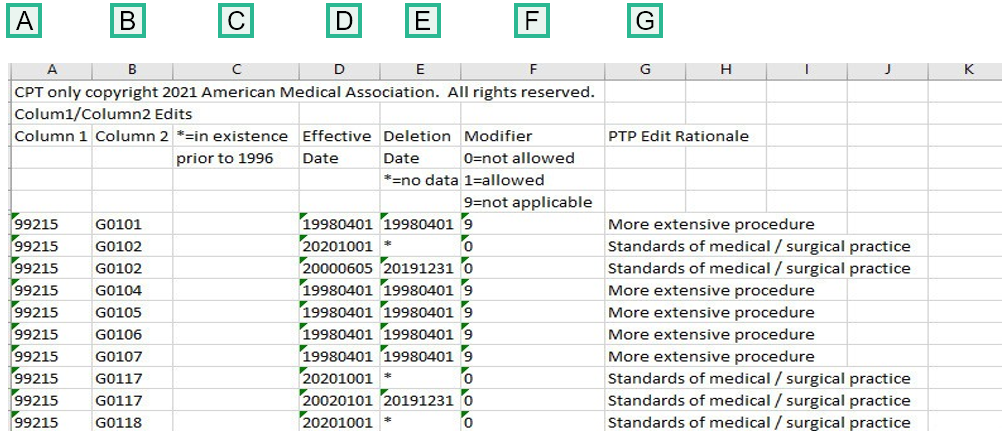
Figure 2: Column 1/Column 2 table with 99215 in Column 1
- Column A shows the payable (Column 1) code.
- Column B shows a Column 2 code that isn’t payable with this Column 1 code, unless an NCCI- associated modifier is permitted and submitted.
- Column C shows the edit status before 1996.
- Column D shows the effective date of the edit (year, month, date).
- Column E shows the deletion date of the edit (year, month, date).
- Column F shows if you can use a modifier. This number is the modifier indicator for the edit. (The Modifier Indicator Table, shown on page 11 of this booklet, gives more explanation.
- Column G provides the category of the rationale for each PTP edit.
Our search shows part of the edit tables for Column 1/Column 2 PTP code pairs where 99215 is the payable code.
Figure 2 shows, you won’t be reimbursed for HCPCS code G0102 (Prostate cancer screening; digital rectal examination) with 99215 (Office or Other Outpatient Visit).
When is a Code the Column 2 Code of a PTP Code Pair?
Unlike the Column 1 search, you should search for Column 2 codes in all of the Practitioner PTP Edits tables. (Similarly, you would need to search all of the hospital tables.) Use the Microsoft Excel filter tool so all instances of a particular code are displayed in Column 2. (The Filtering the PTP Data Tables section on page 11 provides instructions for using the filter tool in Microsoft Excel.)
Note: If you don’t download files and update them every quarter (or when there are replacement files), you’ll be using the wrong files. Be sure to search the files currently available on the Quarterly PTP and MUE Version Update Changes webpage.
For example, code 99215 can appear in Column 2 of Practitioner PTP Edits tables.
If you filter Microsoft Excel for 99215 in Column 2 of the Practitioner PTP Edits Table containing edits from 0001A/0591T1-25999/96523 (or similar range), you’ll see that 99215 isn’t payable with 01462, Anesthesia for all closed procedures on lower leg, ankle, and foot.
If you filter for 99215 in Column 2 of the Practitioner PTP Edits Table containing edits from 61000/0213T- U0003/U0004 (or similar range), you’ll see that 99215 isn’t payable with 99221, Initial hospital care, unless you use an NCCI PTP-associated modifier.
How Do You Know When to Use a Modifier?
In the Correct Coding Modifier Indicators (CCMIs) column, the indicator 0, 1, or 9 shows whether an NCCI PTP-associated modifier allows the PTP code pair to bypass the edit. The following Modifier Indicator Table provides a definition of each of these indicators.
| CCMIs | Definition |
|---|---|
| 0 (Not Allowed) | No modifiers associated with NCCI allow you use this PTP code pair. When no modifiers are allowed, only the Column 1 code will be paid for the same patient on the same day. |
| 1 (Allowed) | You can use NCCI-associated modifiers with this PTP code pair when appropriate. |
| 9 (Not Applicable) | There is no active edit for this PTP code pair. |
Hospital (Outpatient hospital and other facility) PTP Edits:
- Hospital PTP code pair tables work the same as the practitioner PTP code pair tables
- Modifiers and coding pairs may differ from the practitioner PTP code pair tables because of differences between facility and professional services
Note: NCCI doesn’t apply to the Hospital Inpatient Prospective Payment Systems (IPPS).
Filtering the PTP Data Tables
The fastest and most accurate way you can search any of the edit tables for a particular value is by using the Excel Filter feature
Note: We wrote the Filter tool instructions for Excel 2010. If you’re using an earlier version of Excel or another spreadsheet program, the Filter function might work differently. Use the Help feature of your program if you need help.
In the figures below, our example uses the Filter to search for instances of CPT code 99215 in Column 2 of the Practitioner PTP Edits Table 1. These instructions also can be used to filter Column 1 codes in any of the 4 PTP code pair tables.
Open the file in Excel format (.xlsx). Figure 3 shows you how to begin filtering. Choose the Column 2 heading and then choose Data and Filter.
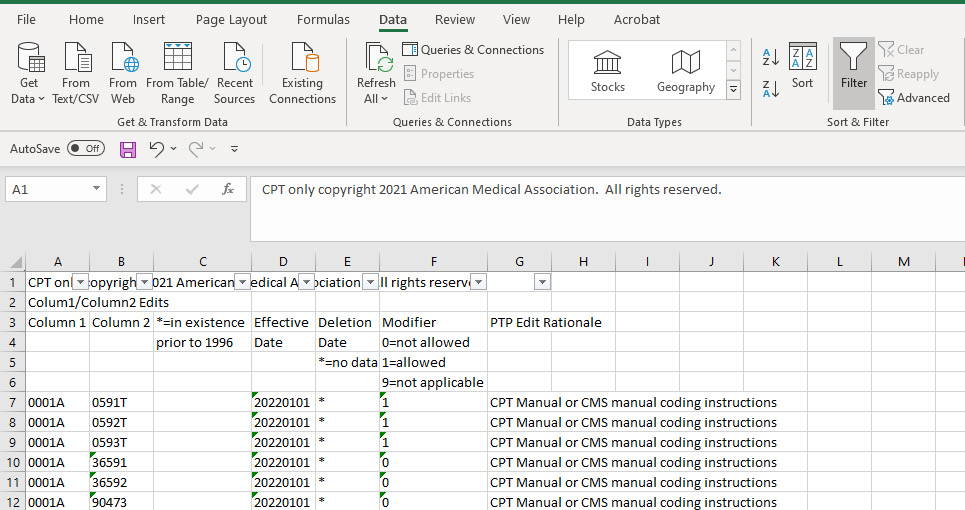
Figure 3: Filter Feature Selected
Excel displays a dropdown arrow on each column header.
Select the dropdown arrow in Column 2. Excel will automatically highlight all values in the column. Choose the check box next to Select All to remove this default. Scroll down to the code you want.
Figure 4 shows Column 2 selected and a sort for 99215 you choose by clicking on the box beside this code. Next, click on OK.
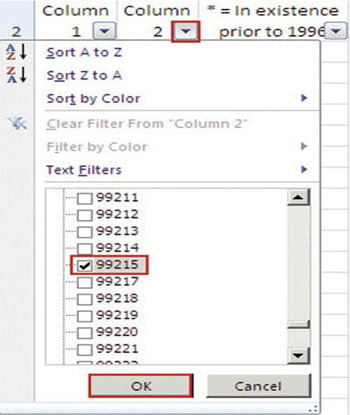
Figure 4: Removing Select All default setting
Figure 5 shows a sample of occurrences of 99215 in Column 2 of the Practitioner PTP Edits Table 1.
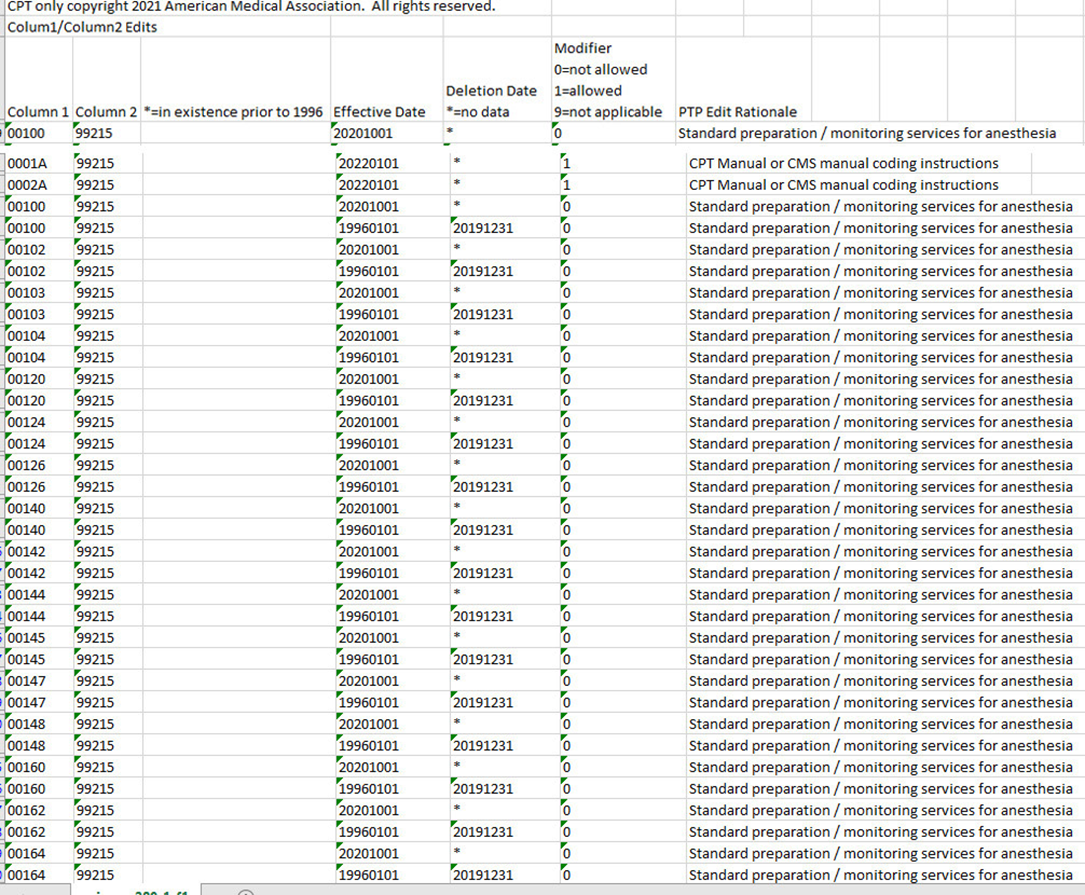
Figure 5: Results of filter for CPT code 99215 in Column 2
When you’re done looking at the records filtered by the code you want, select on the filter symbol in the column you filtered, and select Clear Filter from Column 2 as shown in Figure 6. You should return to viewing all records before you can filter for a different value. When you’re done looking for records, you can remove the Filter by selecting Data and Filter.
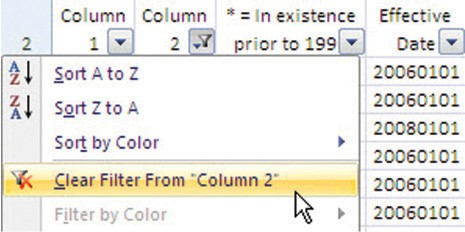
Figure 6: Removing the filter
Helpful Hint
When Excel prepares the list of values in each column, it automatically lists the values in ascending alphanumeric order. So, when you scroll through the list, if the value you’re looking for doesn’t appear in the position on the list where it should fall alphanumerically, the value isn’t on the file.
Looking Up MUEs
An MUE for a HCPCS/CPT code is the maximum UOS you would report under most circumstances for a single patient on a single date of service.
CMS develops MUEs based on:
- HCPCS/CPT code descriptors
- CPT coding instructions
- Anatomic considerations
- Established CMS policies
- Nature of service or procedure
- Nature of analyte
- Nature of equipment
- Prescribing information
- Clinical judgment
Helpful Hint
Most MUEs are visible to providers on the webpage. But CMS considers some MUEs confidential, and they don’t release them. The public or confidential status of MUEs may change.
All claims submitted to MACs, DME MACs, and outpatient facility services claims (Types of Bill 13X, 14X, 85X) are tested against MUEs. Since MUEs are coding edits, rather than medical necessity edits, claims processing contractors may have UOS edits that are more restrictive than MUEs. In those cases, the more restrictive claims processing contractor edit will apply to the claim. Similarly, if the MUE is more restrictive than a claims processing contractor edit, the more restrictive MUE will apply. You should only report services that are medically reasonable and necessary.
To view the tables of MUEs, choose Medically Unlikely Edits from the menu on the left side of the National Correct Coding Initiative Edits webpage. Scroll to the bottom of the page and choose the link to the table you want to review in the Downloads section.
Figure 7 shows the MUE tables for Practitioner Services, Facility Outpatient Hospital Services, and DME Supplier Services in the Downloads section. Links to MUE tables for the current and previous quarter are available.
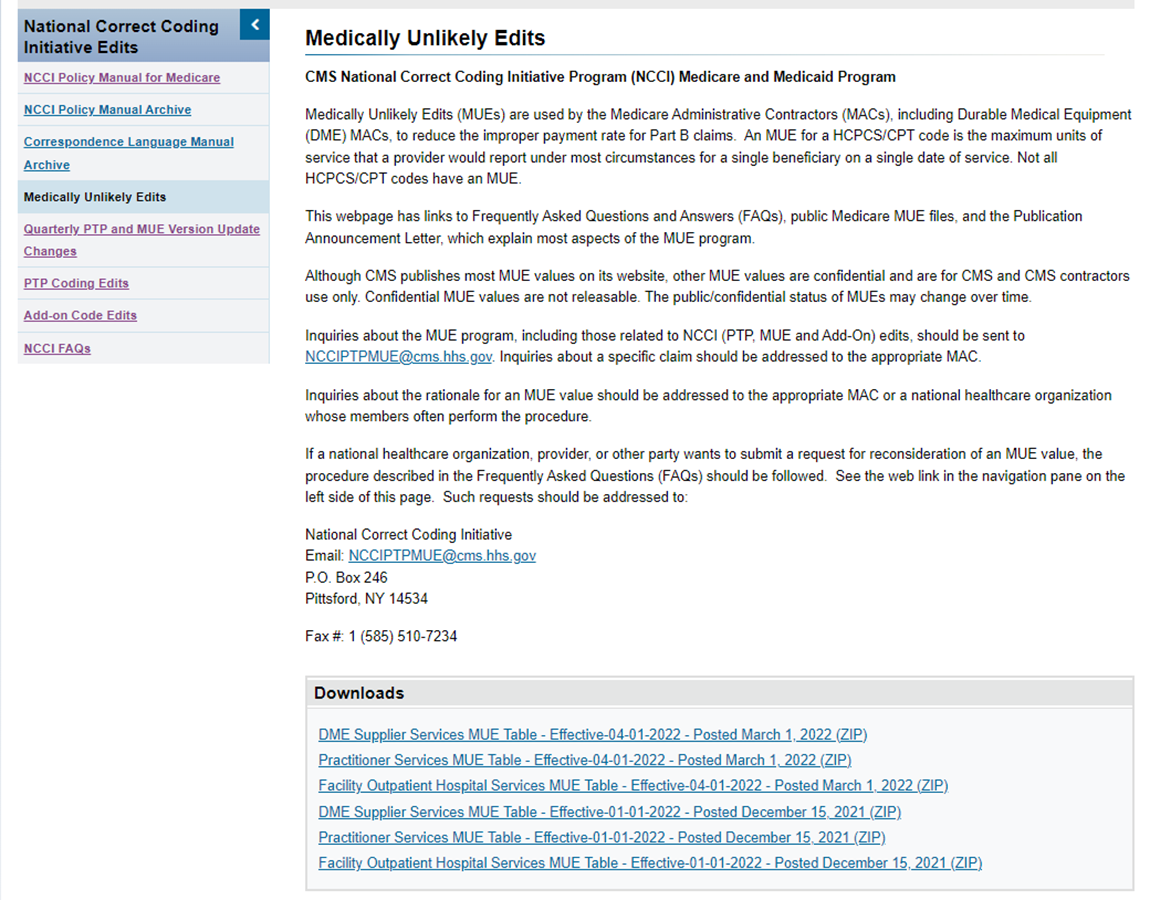
Figure 7: Selecting MUE Provider Type
Helpful Hint
Most MUEs are visible to providers on the webpage. But CMS considers some MUEs confidential, and they aren’t released. The public or confidential status of MUEs may change.
Figure 8 shows a section of the Practitioner Services MUE table after selecting the Microsoft Excel format.
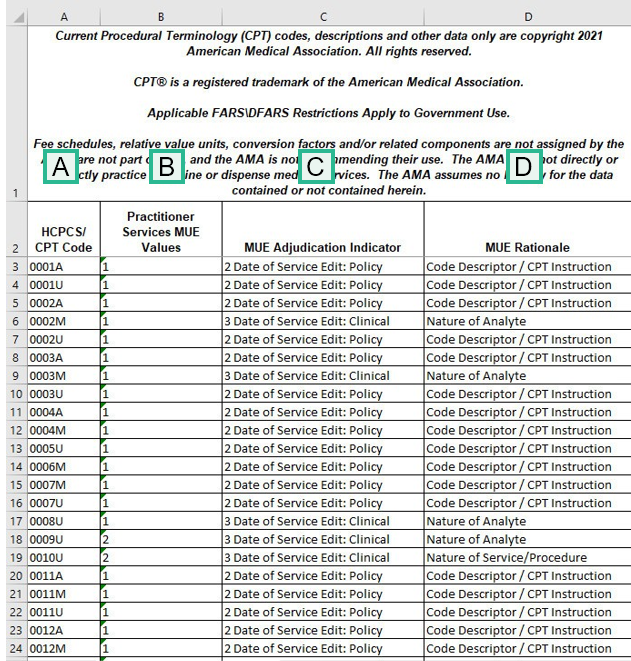
Figure 8: Portion of Medicaid NCCI MUE Dataset
- Column A titled HCPCS/CPT Code shows codes with an MUE value.
- Column B titled Practitioner Services MUE Values shows the maximum UOS that you would report under most circumstances for a single patient on a single date of service.
- Column C titled MUE Adjudication Indicator (MAI) describes the level of adjudication of the MUE
- MAI 1 indicates a value adjudicated by claims processing systems at the claim line level.
- MAI 2 indicates an absolute date of service edit based on policy, such as anatomic considerations, definition of the code, or published CMS policy.
- MAI 3 indicates a value adjudicated by claims processing systems at the date of service level. If claim denials based on these edits are appealed, MACs may pay UOS in excess of the MUE value if there is adequate documentation of medical necessity of correctly reported units. MM8853 has more information on MAIs. Note: MAIs aren’t coding modifiers.
- Column D titled MUE Rationale provides the category of rationale for each MUE.
Helpful Hint
Unlike the PTP code pair tables, the MUE tables don’t have a column for modifiers. Review Chapter 1 of the NCCI Policy Manual for Medicare for information about modifiers and MUEs.


